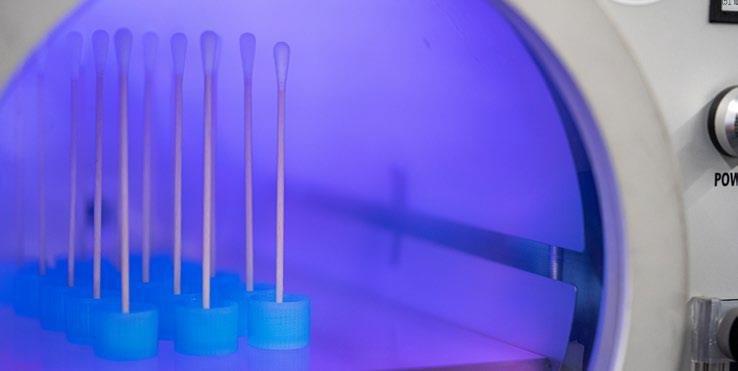HIGHLY ABSORBENT SWABS HELP TO FIGHT THE VIRUS
For almost a year now, the pandemic caused by the SARS-CoV-2 virus has dominated public life. Researchers are giving their all to find a new vaccine, and the development of better tests for disease detection is another crucial factor in the fight against the pandemic. In Germany, approx. 24 million [1] of corona tests have been performed since the start of the pandemic. Today, a corona infection is primarily diagnosed by means of PCR-based detection by means of samples produced by nasal or throat swabs. To this end, cotton buds as sampling tools are of decisive importance. Therefore, a method for optimisation of the absorption capacity is presented and explained in the following. Plasma-treatment of the surface of the bud can increase its absorption capacity many times over, thus helping to improve the sensitivity of corona tests.
The swab
The swab is a long stick with cotton buds at both ends. The sticks are usually made of plastic, paper, wood, or metal. The buds mostly consist of cotton or sometimes of plastic material. Swabs or cotton buds are found in almost every household. They are mostly used in cosmetics, for example for applying eye-shadow, or for applying liquid nitrogen in wart treatment. Q-tips® were originally launched on the market for the purpose of ear cleaning, but today doctors discourage this application. Also in technology, swabs come in handy for cleaning hard-to-reach areas in guns, computers, or printers. [4] The swab sticks manufactured for the medical sector undergo special treatment, usually sterilisation by means of gamma radiation. The material and size of the swab sticks depend on the respective application.
Throat swab
Generally, a swab is a medical procedure for taking from the surface of wounds or mucous membranes a sample of body cells to be examined with the aim of diagnosing certain diseases. To do this, the sample material is collected, depending on the body region, with sterile swabs or small brushes, and examined. Standard sampling for diagnosis of SARS-CoV-2 is performed by means of nose-throat-swabs (nasopharyngeal swabs). Compared to nasopharyngeal swabs, most patients are more comfortable with throat swabs which have a similar or slightly lower diagnostic sensitivity. It is also possible to combine throat swabs and nose swabs. [6]
Sampling
Sometimes, the amount of sample material collected by the medical staff is insufficient for diagnosis, or the treatment of the collected cells or material in the laboratory fails. In these cases, another test must be performed. With the new SARS virus, a test which has not been properly administered may yield false negative results if the collected amount of sample is below detection limits. Particularly in the first days after infection, before the patient has developed symptoms, the virus concentration is so low that the swab must be taken from exactly the right spot to collect a sufficient amount of sample. In case of self-swabbing tests, supervision by trained medical staff is not possible. Often, self-swabbing tests do not yield reliable results and are thus unfit for large-scale use. An optimisation of the cotton buds can increase the reliability primarily in corona self-swabbing tests, and thus further ease the pressure on the test centres.
Optimised swabs
Nowadays, plasma applications can be found in all industries, whether medicinal devices, automotive components or consumer goods. Plasma treatment can also improve the surface properties of cotton swabs used for these non-medical applications. Plasma, also called the “fourth state”, is reached by continued supply of energy to a gas. Reactive species are generated (negatively charged electrons and positively charged ions) which interact with the surface of the components, changing its properties.
Benefits of plasma-treated swabs
• The absorption of liquid is increased by approx. factor 4
• The detection limit of the PCR process is improved
• The sample material of the swabs is not impaired
• There are no restrictions regarding the gamma sterilisation of the buds
Quellen
Laborbericht: https://d3krux2s64mzgx.cloudfront.net/fileadmin/user_upload/News/Abstrichtupfer/Report_Diener_2020JE0002.pdf
1) https://www.rki.de/DE/Content/InfAZ/N/Neuartiges_Coronavirus/Testzahl.html
2) https://www.rki.de/DE/Content/InfAZ/N/Neuartiges_Coronavirus/nCoV.html
3) https://www.leading-medicine-guide.de/diagnostik/abstrich
4) https://forum.chip.de/discussion/18965/drucker-schmiert
5) https://www.who.int/publications/i/item/laboratory-testing-for-2019-novel-coronavirus-in-suspected-human-cases-20200117
6) https://www.rki.de/DE/Content/InfAZ/N/Neuartiges_Coronavirus/Vorl_Testung_nCoV.html?nn=13490888
Diener electronic GmbH + Co. KG
Nagolder Staße 61
72224 Ebhausen
Telefon: +49 (7458) 99931-0
Telefax: +49 (7452) 88807-50
http://www.plasma.com
E-Mail: press@plasma.com
![]()

